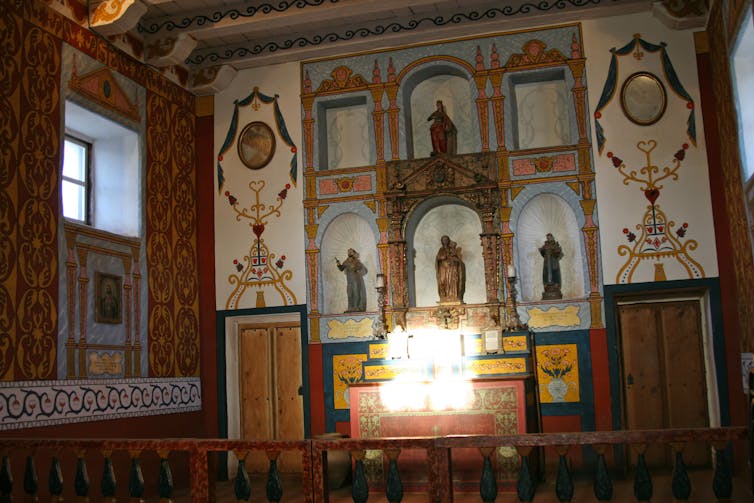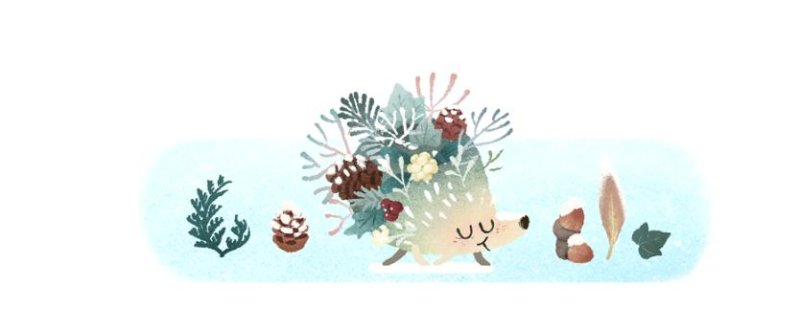The winter solstice happens every year when the Sun reaches its most southerly declination of -23.4 degrees. In other words, it is when the North Pole is tilted farthest away from the Sun, delivering the fewest hours of sunlight of the year.
The Sun is directly overhead of the Tropic of Capricorn in the Southern Hemisphere during the December solstice and is closer to the horizon than at any other time in the year, meaning shorter days and longer nights.
The shortest day of the year lasts for 7 hours 49 minutes and 42 seconds in London, which is over 9 hours shorter than the June Solstice. As such, Monday December 21 will be the longest night of the year.
The day after the winter solstice marks the beginning of lengthening days, leading up to the summer solstice in June.
In the Southern Hemisphere, the opposite is true. Dawn comes early, and dusk comes late. The sun is high and the shortest noontime shadow of the year happens there. In the Southern Hemisphere, people will experience their longest day and shortest night.
Does the winter solstice always fall on December 22nd?
While it more often than not falls on December 21 or 22, the exact time of the solstice varies each year. In the Northern hemisphere the winter solstice is the shortest day of the year, because it is tilted away from the sun, and receives the least amount of sunlight on that day.
However, the earliest sunset does not occur on the solstice, because of the slight discrepancy between 'solar time' and the clocks we use.
The shortest day of the year often falls on December 21, but the modern calendar of 365 days a year - with an extra day every four years - does not correspond exactly to the solar year of 365.2422 days.
The solstice can happen on December 20, 21, 22 or 23, though December 20 or 23 solstices are rare.
The last December 23 solstice was in 1903 and will not happen again until 2303.
Read more: What a Covid Christmas will look like in 2020
What does 'solstice' mean?
The term 'solstice' derives from the Latin word 'solstitium', meaning 'Sun standing still'. On this day the Sun seems to stand still at the Tropic of Capricorn and then reverses its direction as it reaches its southernmost position as seen from the Earth.
Some prefer the more teutonic term 'sunturn' to describe the event.
Is the solstice the first day of winter?
The answer might vary depending on who you ask. There are two types of winter: astronomical and meteorological.
This year, astronomical winter begins on December 21, with the winter solstice, and ends on March 20 2021. Meteorological winter always begins on December 1 and ends on February 28 (February 29 during leap years).
While astronomical winters are determined by the Earth's orbit around the sun, meteorological winters are the three calendar months with the lowest average temperatures.
The Met Office tend to use the meteorological definition of the seasons.
Stonehenge and the solstice
Scores arrive at the prehistoric monument in Wiltshire to mark the occasion. Why is the site so important?
Stonehenge, the prehistoric monument located in Wiltshire, is carefully aligned on a sight-line that points to the winter solstice sunset (opposed to New Grange, which points to the winter solstice sunrise, and the Goseck circle, which is aligned to both the sunset and sunrise).
Archaeologists believe it was constructed from 3000 BC to 2000 BC and it is thought that the winter solstice was actually more important to the people who constructed Stonehenge than the summer solstice.
The winter solstice was a time when cattle were slaughtered (so the animals would not have to be fed during the winter) and the majority of wine and beer was finally fermented.
The only other megalithic monuments in the British Isles which clearly align with the sun are Newgrange in County Meath, Ireland and Maeshowe situated on Mainland, Orkney, Scotland.
You can also see the solstice sunrise around the world; this website shows the streets in cities around the world where you can get a clear view of the sun rising on the morning of the solstice.
How is the solstice being celebrated at Stonehenge this year?
In the pagan and druid communities, they celebrate the first sunrise after the astronomical event - and English Heritage time their official event in line with this.
This year, celebrations at Stonehenge fall on Monday December 21, with the sun rising at 6:52am if it still goes ahead. A spokesperson for Stonehenge said: "This year we haven’t been able to host the usual gatherings for summer solstice and the equinoxes at Stonehenge because of the Coronavirus pandemic. As we approach the winter solstice we are keeping the situation under review and will make a decision informed by the latest advice from Government and local partners nearer the time."
In 2009, a crowd wearing traditional costume, met at Stonehenge on December 21 morning to mark the rising of the sun on the shortest day of the year. But unfortunately their calculations were slightly out meaning they had in fact arrived 24 hours prematurely.
The '09 solstice fell at exactly 5:47pm that day, and because the sun had already set, the official celebrations were due to take place at sunrise the next day.
English Heritage, who manage the ancient site in Wiltshire, decided to open the gates anyway and welcome those who had made a miscalculation.
A spokesman for English Heritage said at the time: "About 300 people turned up a day early. We took pity on them and opened the stone circle so they could celebrate anyway. They were a day early but no doubt had a wonderful time as well.
Arthur Pendragon poses as Druids, pagans and revellers gather in the centre of Stonehenge, hoping to see the sun rise, as they take part in a winter solstice ceremony
"People always assume that because the summer solstice is the June 21, the winter solstice will be December 21. They should always check because it does change."
Pagan leader Arthur Pendragon said: "It is the most important day of the year for us because it welcomes in the new sun.
"There were hundreds of people there. If we'd celebrated on the 21st it would have been the right day but the wrong sun – when the whole point of the occasion is about welcoming in the new sun."
Why isn’t the earliest sunset on the year’s shortest day?
Solar noon - the time midway between sunrise and sunset - is when the sun reaches its highest point for the day, but the exact time of solar noon, as measured by Earth’s spin, shifts.
A clock ticks off exactly 24 hours from one noon to the next but actual days – as measured by the spin of the Earth – are rarely exactly 24 hours long.
If the Earth’s spin is measured from one solar noon to the next, then one finds that around the time of the December solstice, the time period between consecutive solar noons is actually 30 seconds longer than 24 hours.
Therefore two weeks before the solstice, for example – the sun reaches its 'noontime' position at 11:52am local standard time.
Two weeks later - on the winter solstice – the sun reached that noontime position at 11:59am - seven minutes later.
The later clock time for solar noon also means a later clock time for sunrise and sunset. The result? Earlier sunsets before the winter solstice and increasingly later sunrises for a few weeks after the winter solstice.
The exact date of earliest sunset varies with latitude but the sequence is always the same.
For the Northern Hemisphere the earliest sunset occurs in early December and the latest sunrise happens in early January. This year the earliest sunset is on December 12 and the latest sunrise for next year on January 4 2021.
Solstice celebrations around the world
The December solstice marks the 'turning of the Sun' as the days slowly get longer. Celebrations of the lighter days to come have been common throughout history with feasts, festivals and holidays around the December solstice celebrated by cultures across the globe.
Saturnalia
The winter solstice festival Saturnalia began on December 17 and lasted for seven days in Ancient Rome.
These Saturnalian banquets were held from as far back as around 217 BC to honour Saturn, the father of the gods.
The holiday was celebrated with a sacrifice at the Temple of Saturn, in the Roman Forum, and a public banquet, followed by private gift-giving, continual partying, and a carnival atmosphere that overturned Roman social norms.
The festival was characterised as a free-for-all when all discipline and orderly behaviour was ignored.
Wars were interrupted or postponed, gambling was permitted, slaves were served by their masters and all grudges and quarrels were forgotten.
It was traditional to offer gifts of imitation fruit (a symbol of fertility), dolls (symbolic of the custom of human sacrifice), and candles (reminiscent of the bonfires traditionally associated with pagan solstice celebrations).
The Saturnalia would degenerate into a week-long orgy of debauchery and crime – giving rise to the modern use of the term 'saturnalia', meaning a period of unrestrained license and revelry. A mock 'king' was even chosen from a group of slaves or convicts and was allowed to behave as he pleased for seven days (until his eventual ritual execution).
The poet Catullus considered it to be "the best of days."
Yalda
Yalda or Shab-e Chelleh ('night of forty') is an Iranian festival celebrated on the "longest and darkest night of the year," i.e. the night of the Northern Hemisphere's winter solstice.
Every year, on the date of the Winter solstice, Iranians celebrate the arrival of winter, the renewal of the sun and the victory of light over darkness on Yalda Night.
Ancient Iranians believed that the dawning of each year is marked with the re-emergence or rebirth of the sun, an event which falls on the first day of the month of Dey in the Iranian calendar (December 21).
On this day, the sun was salvaged from the claws of the devil, which is represented by darkness, and gradually spread its rays all over the world to symbolise the triumph of good over evil. Family members get together (most often in the house of the eldest member) and stay awake all night long in Yalda.
Pomegranate, watermelon and dried nuts are served as a tradition and classic poetry and old mythologies are read in the gathering.
It is believed that eating watermelons on the night of Chelleh will ensure the health and well-being of the individual during the months of summer by protecting him from falling victim to excessive heat or disease.
In Khorasan, there is a belief that whoever eats carrots, pears, pomegranates, and green olives will be protected against the harmful bite of insects, especially scorpions. Eating garlic on this night protects one against pains in the joints.
Getting a ‘Hafez reading’ from the book of great Persian poet Shamsu d-Din Muhammad Hafez-e Shirazi is also practiced.
Another custom performed in certain parts of Iran on the night of Chelleh involves young engaged couples. The men send an edible arrangement containing seven kinds of fruits and a variety of gifts to their fiancees on this night.
In some areas, the girl and her family return the favour by sending gifts back for the young man.
























